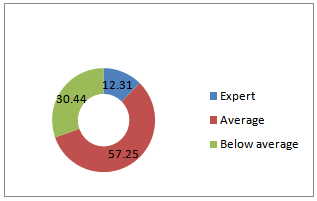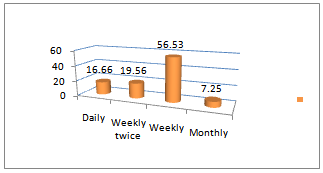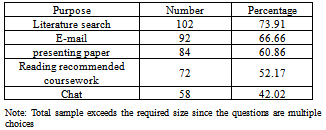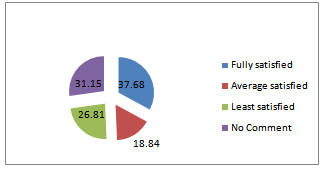S. Thanuskodi
Department of Library & Information Science Alagappa University, Karaikudi, 630 003, India
Correspondence to: S. Thanuskodi , Department of Library & Information Science Alagappa University, Karaikudi, 630 003, India.
| Email: |  |
Copyright © 2012 Scientific & Academic Publishing. All Rights Reserved.
Abstract
The use of information and communication technologies no doubt is gaining momentum in Indian higher education . The Internet is used by faculty, staff and students in sourcing information. Information and communication technologies assist libraries in providing efficient and current information services. Once the staff and students are able to use these technologies effectively, the teaching, learning and research activities in the college will be made easier for the college community. ICT usage will facilitate development since there will be free flow of information. The electronic revolution, specifically, Internet is narrowing the information gap. The power of web technology is enabling the generator of information to disseminate their creativity at low cost and high speed. Internet is the gateway for libraries and information centers to enter the Electronic Information Era and is providing the information, generated by different organizations, institutions, research centers and individuals all over the world. This paper is an attempt to investigate the use of Information and Communication Technology among the students of rural areas in Tamil Nadu. For this purpose a survey was carried out using questionnaire tool. The findings indicated that more than half acquired their internet skill through training from the college. The results indicated majority of students used Internet weekly (56.53%). The study found that most of the respondents 73.91% use internet for literature search.
Keywords:
ICT, Internet, E-Resources, Online Help, Websites, CD-ROM, Information Needs
Cite this paper: S. Thanuskodi , Awareness and Use of ICT among Under Graduate Degree Students of Rural Areas in Tuticorin District, India: A Study, International Journal of Information Science, Vol. 3 No. 1, 2013, pp. 1-6. doi: 10.5923/j.ijis.20130301.01.
1. Introduction
The information and communication technology revolution is sweeping through the world and the gale has even caught up with developing countries like India. Information and communication technologies have introduced new methods of teaching and conducting research and have been brought into education facilities for online learning, teaching and research collaboration. While some college communities in some countries enjoy free or inexpensive Internet access, students and faculty/staff in India must pay for time spent accessing the Internet, whether at a cyber café or in the library (some of the library they are providing free access). To improve ICT services in the library, therefore, researchers need to show how students and faculty/staff are using the Internet in the academic environment. Information and communication technologies have given rise to new modes of organizing the educational environment in schools and new concepts in the teaching process as well as the remodeling of the roles played by the participants in the educational process.Today libraries are undergoing transformation, on one side they are facing three major challenges – shrinking budgets, shortage of space and increasing cost of publications, and on the other side are the challenges posed by advances in the field of information and communication technology. The remarkable growth of electronic information in the last few decades has changed the scenario and has solved the problem of space. In this digital era digitized information is available on CDs, audio cassettes, video cassettes etc., as well as on the internet. This property, which Daniel Atkins calls digital coherence, allows all the objects in a digital library – sounds, images, texts, and everything else – to be treated in essentially the same way. The information technology has changed the complexion of the libraries in a big way. Electronic resources play a vital role in the field of science and engineering studies.Electronic access to technology journals has become important and valuable tool for researchers, students and faculty. The user community is becoming more and more familiar with these tools and now they have started using them very regularly.In India the Ministry of Human Resource Development (MHRD), has set-up the UGC-Infonet Digital Library Consortium was formally launched in December, 2003 by Honourable Dr. A P J Abdul Kalam, the President of India soon after providing the Internet connectivity to the universities in the year 2003 under the UGC-Infonet programme. The Consortium proved to be a recipe to university libraries which have been discontinuing subscription of scholarly journals because of "Serials Crisis". The term "serials crisis" refers to exponential and continuing increase in subscription cost of scholarly journals. The crisis is a result of rise in cost of journals much faster than the rate of inflation, increase in number of journals and the paucity of funds available to the libraries The Consortium provides current as well as archival access to more than 7000+ core and peer-reviewed journals and 10 bibliographic databases from 26 publishers and aggregators in different disciplines. The programme has been implemented in phased manner. In the first phase that began in 2004, access to e-resources was provided to 50 universities who had Internet connectivity under the UGC-Infonet Connectivity programme of the UGC. In the second phase, 50 more universities were added to the programme in the year 2005. So far 277 Universities come under the purview of UGC, have been provided differential access to subscribed e-resources. These e-resources covers almost all subject disciplines including arts, humanities, social sciences, physical sciences, chemical Sciences, life sciences, computer sciences, mathematics and statistics, etc. The programme is wholly funded by the UGC and executed by the INFLIBNET (Information and Library Network) Centre, Ahmedabad.
2. Literature Review
Ray and Day (1998) conducted their study to determine the level of use of electronic resources and how students feel about various issues surrounding electronic resources. In their paper titled, "Student Attitude towards Electronic Information Resources", they used questionnaire method. The findings of their study are that 91 per cent of respondents acknowledged access to a networked computer via university, and also that more internet access is from work place than from home. The most popular electronic resources used were CD-ROM and the internet. Only 37.5 per cent of the sample population used electronic journals as an information tool[1].Lenares (1999) in his research study titled “Use of electronic journals at research institution” found that there was rapidly growing acceptance of electronic journals by faculty within the scholarly community. The increase in electronic journals usage is accompanied by a decrease in the frequent use of print journals. Print journal usage, however, continues to dominate electronic journal usage. Only 14 per cent of respondents used electronic journals frequently as compared to 65 per cent using print journals frequently. Questionnaire was sent through e-mail to randomly selected faculty members from the university directory[2].Crawford and Daye (2000) studied “A Survey of the Use of Electronic Services Glasgow Caledonian University library”. The survey used observational and questionnaire based method. The questionnaire was administered both on paper and electronically. The results show that most of the respondents were full time students and were using PC rather than Mac, 18 per cent used CD-ROMs and only 13 per cent used online databases. About one-third of the respondents had problem in using the electronic information floor (elf). Information searching restricted to bulk of the work is the same as that done in other parts of the university[3].Zhang (1999) in his the paper titled “Scholarly Use of Internet-based Electronic Resources,” made an attempt to know how scholars use, cite, and evaluate e-resources during the research. Three approaches were used to collect data for the investigation (a) a longitudinal analysis of e-journals from 1991 through 1998, (b) a survey of editors of the eight journals; and (c) a survey of 201 authors with articles to be published in the eight journals. The results of this study shows that there has been a notable increase in the number and proportion of authors who cite e-resources in their research articles over an eight year period but e-sources were still cited much less frequently than print sources. E-resources are increasingly used among scholars and also becoming an important component in their research[4].Herring (2002) in the paper titled “Use of Electronic Resources in Scholarly Electronic Journals: A Citation Analysis” studied through citation analysis of research articles from scholarly electronic journals published in 1999-2002, to know the scholars using electronic resources and the type /subject area of online resources that are being referenced. The researcher brought out that online resources are increasingly important for today’s scholars and researchers. There is change in information seeking behavior. The use of information resources is greater as scholars and researchers feel comfortable and familiar with the resources available through the web[5].Yang (2003) conducted a study titled, “Internet Use by Pre-service Teachers in Elementary Education Instruction” which explored the attitude of pre-service elementary educators towards internet use, internet self-efficacy, and internet anxiety and their relationship. The respondents of this survey were all elementary pre-service students enrolled in Core College of Education courses at Idaho State University during 2003. The questionnaires were distributed to 98 students’ during regularly scheduled class time and a total of 71 responses were obtained. The implications of the findings suggested that an early and frequent use of the internet across the teacher education curricula was useful in promoting students' internet use and self-efficacy[6].Choukhande and Kumar (2004) have studied the information needs and use pattern in their paper titled “Analytical Study of Information Needs and Use Pattern of Faculty Members and Research Scholars of Amravati University”. They used a questionnaire method with random sampling technique to collect the data. Some of the findings are: users face difficulty in searching information through electronic sources, and they need skill to use the available sources in the library[7].Razaand and Upadhyay (2006) A survey was carried out to examine the usage of ejournals by the researchers at Aligarh Muslim University. They used questionnaire method to find out purpose and place used by research scholars for using e-journals. The survey reveals that all the researchers are aware of e-journals in AMU. Many research scholars are consulting e-journals from their departmental labs and computer centers, not only for research purposes but also to update their own knowledge. Some problems like lack of training and slow downloading has been found and the researchers felt about the need for print journals as well as electronic journals[8].Asefeh and Nosrat (2007) carried a survey to investigate the relationships between awareness and use of digital resources among students in Isfahan University of Medical Sciences. A questionnaire was design with descriptive method was randomly used for survey. 250 users of the Medical libraries and information centers affiliated to Isfahan university of Medical Sciences were taken for survey. The results were founding the paper titled “Awareness and use of digital resources in the libraries of Isfahan University of Medical Sciences, Iran” that 70 percent of students were aware of digital resources, but 69 percent have used them; 62 percent were aware of offline databases and 19 percent were only using them through Central library LAN network. About 70 percent were aware of online databases, accessible via Central library web site and 53 percent have used them In total 87 percent of students felt that the available data met their information needs. Infrequent periodic orientation and lack of education on use of offline databases and fewer terminals connected to the server in the Central library, due to these factor students had less use offline databases. Users are faced with problems like low speed connectivity and shortage of hardware facilities[9].Kanwal, Ameen (2008) studied the “Barriers in Collection Sharing among Libraries of Pakistan: University Library Managers’ Viewpoint”. A survey method was used to explore the barriers to collection sharing among the well-established chartered university libraries situated in the major cities of Pakistan. The survey followed a qualitative design based on an interview technique of data collection. Twenty chief/head librarians from five major cities of Pakistan were interviewed. In-depth, semi-structured interviews were conducted at the librarians’ workplaces during 2003 to 2004. The results of the present study revealed that various technical, procedural, psychological, and behavioral barriers in achieving planned and meaningful collection-sharing (CS) programs still prevail. It suggests analyzing the possibilities, opportunities, and challenges of CS in the emerging paradigm[10].
3. Objectives of the Study
The main objectives of the present study are as follows:• To find out the awareness of Information and Communication Technology.• To study the purpose and utilization of ICT.• To find out the frequency of using ICT.• To find out the hindrances and problems faced by the users while accessing and using ICT.• To study the level of satisfaction of users about availability and coverage of ICT.• To study the satisfaction level of users about infrastructure to support the access of ICT.• To suggest suitable recommendations to improve facilities and services related to the use of ICT.
4. Methodology
The study used a questionnaire, with 20 questions spread over the following areas General profile of the respondent, Attitude towards ICT, Use of ICT, ICT skill of rural students, access to Education Information on the Web and Constraints. To facilitate quantification and analysis of data, mainly close-ended questions were used along with checklists and rating scales. To capture a response and to have fewer missing responses, options such as “no opinion”, “don't know”, and “don't know about it” are also included. A random sample of 150 under graduate students located in rural areas of Tuticorin District, was selected and questionnaires were distributed among them. Of those, 138 (92.00%) questionnaires were returned completed.
5. Data Analysis and Discussion
Analysis of data is the ultimate step in research process. It is the link between raw data and significant results leading to conclusions. This process of analysis has to be result oriented.
5.1. Population Study
| Table 1. Sex wise distribution of Respondents |
| | Gender | No. of Respondents | Percentage | | Male | 97 | 70.29 | | Female | 41 | 29.71 | | Total | 138 | 100.00 |
|
|
 | Figure 1. Sex wise distribution of Respondents |
Personal detail section of the questionnaire provides information regarding the sex and different qualifications as can be seen from Table-1. It is shown in table-1, 70.29 % of population studied were males and only 29.71 % of total were females, who can use internet and e-resources for different purposes[Fig.1].
5.2. Use of Internet & e-resources
| Table 2. Experience of Internet Use |
| | Years of Experience | Number | Percentage | | 1-3 years | 76 | 55.07 | | 3-5 years | 34 | 24.64 | | 5 years and above | 28 | 20.29 | | Total | 138 | 100.00 |
|
|
Table-2 shows that on an average majority of the respondents have ranged 1-5 years experience of Internet use. Only 20.29 % have more than 5years of experience of Internet use. | Table 3. Internet Skill Rating |
| | Rating | Number | Percentage | | Expert | 17 | 12.31 | | Average | 79 | 57.25 | | Below average | 42 | 30.44 | | Total | 138 | 100.00 |
|
|
 | Figure 2. Internet Skill Rating |
The respondents were asked to indicate their skill of internet literacy. It is evident from Table-3 that majority of the respondents (57.25%) have an average level of Internet skill. 30.44 % of the respondents reported that they have below average level of internet skill. Only 12.31 % admitted that they are expert in internet skill[Fig.2]. | Table 4. Internet Skill learning Method |
| | Method | Number | Percentage | | Training from the College | 74 | 53.63 | | Self study / Instruction | 27 | 19.56 | | From Friends | 23 | 16.66 | | External Sources | 14 | 10.15 | | Total | 138 | 100.00 |
|
|
 | Figure 3. Internet Skill learning Method |
Table -4 shows more than half acquired their internet skill through training from the college, 19.56 % learned from self study, 16.66 learned from friends. Only 10.15 % acquired skills from external sources[Fig.3].| Table 5. Place of Internet access |
| | Location | Number | Percentage | | College | 82 | 59.42 | | Café | 34 | 24.64 | | Home | 22 | 15.94 | | Total | 138 | 100.00 |
|
|
Table-5 highlights the location from where the Internet and electronic resources are mostly accessed by the under graduate students of rural areas. A majority of the respondents i.e.59.42 % access the Internet from the College, while 24.64 % also access from café. Another 15.94 % access Internet from home.| Table 6. Internet Use Frequency |
| | Duration | Number | Percentage | | Daily | 23 | 16.66 | | Weekly twice | 27 | 19.56 | | Weekly | 78 | 56.53 | | Monthly | 10 | 7.25 | | Total | 138 | 100.00 |
|
|
 | Figure 4. Internet Use Frequency |
In response to the question how frequently do you use Internet? The respondents have responded in different ways (Table-6) Majority of students used Internet weekly (56.53%), daily (16.66 %) and weekly twice (19.56%). Only few students (7.25) used internet monthly[Fig.4]. | Table 7. Most Frequently used Internet & e-Resources |
| | Services | Number | Percentage | | E-mail | 58 | 42.02 | | E-journals | 37 | 26.82 | | E-books | 18 | 13.04 | | E-Databases | 13 | 9.43 | | DVD / CD-ROMs | 12 | 8.69 | | Total | 138 | 100.00 |
|
|
 | Figure 5. Internet & e-Resources |
Table-7 indicates the use of Internet services and electronic resources. The use of e-resources and Internet services in order of preference is 42.02 % E-mail, 26.82 % E-journals, 13.04 % E-books, 9.43 % E-databases and 8.69% DVD/CD-ROMS[Fig.5].
5.3. Purpose of Using Internet and E-resources
Table 8. Purpose of using Internet and E-resources
 |
| |
|
From the table-8, it is clear that most of the respondents 73.91% use internet for literature search. 66.66% of respondents use internet for e-mail. 60.86 % of respondents use internet for paper presentation and 52.17 % respondents use for reading recommended coursework. 42.08 % of users using internet for chatting.
5.4. Constraints in Use of ICT
Table 9. Problems accessing electronic information
 |
| |
|
Though electronic information have become a common source among the academic and research communities, the majority of users stated that they have difficulties to use internet. The specific problems faced by the users are given in table-9. More than half of respondents stated that lack of support from IT staff, with a nearly equal number who saw a lack of time to use. Around Half indicated no computer lab, no campus computer network, and significant numbers also mentioned the ICT not present in syllabus, with a one third number mentioning inadequate number of PCs and no Internet Connectivity.| Table 10. Level of Satisfaction |
| | Satisfaction Level | Number | Percentage | | Fully satisfied | 52 | 37.68 | | Average satisfied | 26 | 18.84 | | Least satisfied | 37 | 26.81 | | No Comment | 43 | 31.15 | | Total | 138 | 100.00 |
|
|
 | Figure 6. Level of Satisfaction |
Table-10 only 37.68% of respondents were fully satisfied, 18.84% of the respondents average satisfied, 26.81% of respondents least satisfied and 31.15 % of respondents no comment[Fig.6].
6. Suggestions
Based on the findings of the study, the following suggestions are made to improve the use of the Internet resources by the under graduate students of rural areas in Tuticorin District:• More number of terminals should be provided in the Library. Some computers with floppy disk/CD-ROM drives/USB ports may be provided in the library so that the users can download relevant information from the Internet and take to their departments and read it leisurely. That helps not only to them but also to others in getting more time in searching information on the Internet.• There is a need for extensive training programme on regular basis at the beginning of each semester. This is required for all the categories of library users so that they can use Internet-based resources optimally for their studies and research.• In future, the Internet facility should be extended to the hostels. More computers with latest specifications and multimedia kit should be installed so that users can use Internet telephony, video-conferencing, chatting and other useful services of the Internet.• Entertainment websites should be blocked so that students should not unnecessarily sit and block the computers from use by others serious users.
7. Conclusions
Electronic resources opened up many exciting opportunities and potentials for academic libraries. Electronic resources have both advantages and disadvantages. Librarians need to be able to identify and balance the factor that would make e-journals a success in their libraries. Looking at the present situation of information explosion and competency in acquiring it, it is on the part of the library staff to create more awareness about the electronic resources availability among the users and provide them a friendly environment so that they can make a better use of the facility. The use of information and communication technologies no doubt is gaining momentum in Indian colleges. The Internet is used by faculty, staff and students in sourcing information. Information and communication technologies assist libraries in providing efficient and current information services. Once the staff and students are able to use these technologies effectively, the teaching, learning and research activities in the university and college will be made easier for the university and college community. ICT usage will facilitate development since there will be free flow of information.
References
| [1] | Ray, Kathryn and Day, Joan. Student Attitudes Towards Electronic Information Resources. Information Research, 1998. 4(2),1-32. |
| [2] | Lenares, Deborah. Faculty Use of Electronic Journals at Research Institution. ACRL Ninth National Conferences; Detroit Michigan, 1999 April 8-11. |
| [3] | Crawford, John C and Daye, Andrew. A Survey of the Use of Electronic Services at Glasgow Caledonia University Library. The Electronic library. 2000,18(4), 255-265. |
| [4] | Zhang, D. Using the Internet for Research: Factors that affect its Adoption and Utilization by Doctoral Students (Diffusion of Innovation, Graduate Students),” 1999 (Doctoral dissertation, Texas A&M Commerce-Commerce) Dissertation Abstracts International, 69, 1095. |
| [5] | Herring, Susan Davis. Use of Electronic Resources in Scholarly Electronic Journals: A Citation Analysis. College and Research Libraries. 2002, pp. 334-340. |
| [6] | Yang, Shi-Wen. Internet Use by Pre-Service Teachers in Elementary Education Instruction. Dissertation, Idaho State University, DAI-A 64/06 (2003):189.7, July 2004 http://www.ub.uni.com/disertations/fullcit/3094895 (accessed on 20/5/11) |
| [7] | Choukhande, Vaishali G.; and Kumar P.S.G. Analytical Study of Information Needs and Use Pattern of Faculty Members and Research Scholars of Amravati University. ILA Bulletin.2004, 40 (3), 23-31. |
| [8] | Razaand, M.M and Upadhyaye A.K. Usage of E-journals by Researchers in Aligarh Muslim University: A Study. The International Information & Library Review. 2006, 38 (3), 170-179. |
| [9] | Asefeh,Asemi and Nosrat Riyahiniya. “Awareness and Use of Dgital Resources in the Libraries of Isfahan University of Medical Sciences, Iran.” The Electronic Library. 2007, 25(3), 316-327. |
| [10] | Kanwal, Ameen. Barriers in Collection Sharing among Libraries of Pakistan:University Library Managers’ Viewpoint. Library and Information Science Research Electronic Journal, 2008, 18 (1), March http://libres.curtin.edu.au/ (accessed on 20/5/11) |







 Abstract
Abstract Reference
Reference Full-Text PDF
Full-Text PDF Full-text HTML
Full-text HTML
